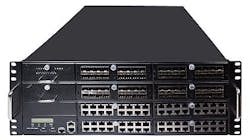Quad-processor rackmount computer for embedded control introduced by WIN Enterprises
NORTH ANDOVER, Mass., 24 March 2013. WIN Enterprises Inc. in North Andover, Mass., is introducing the PL-80480 4U quad Intel Sandy Bridge-EP/Ivy Bridge-EP Xeon aS rackmount computer for embedded control applications.
WIN Enterprises developed the embedded computing processor to provide maximum performance and networking capacity scalable to 128 Gigabit Ethernet LAN ports. Systems designers can select Intel E5-4600 series processors with four, six, and eight cores.
The Intel QuickPath Interconnects running speeds to eight gigatransfers per second combine with quad Intel Xeon E5-4600 series processors (Socket R) to provide reduced cross-socket memory I/O latencies and increased datastream throughput.
Four E5-4600 series processors have as many as 32 cores, 80 megabytes cache, and PCI Express 3.0 interface provide 160 PCI Express lanes with speeds to eight gigabits per second per lane.
Each CPU socket supports four DDR3 channels with speeds to 1600/1866 MHz and a maximum capacity of as much as 256 gigabytes of ECC memory employing LR DIMM technology.
The Intel 7 series C604 chipset supports I/O and high speed mass storage using two 3.5- inch SATA hard disks or solid state drives. The PL-80480 offers a range of LAN expansion modules, such as one for 10 Gigabit SFP+; a Gigabit copper module with by-pass; and Gigabit fiber port modules that combine to provide the ability to configure to a maximum LAN capacity of 128 Gigabit Ethernet ports.
For more information contact Win Enterprises online at www.win-ent.com.
Related stories
PC/104-Plus embedded computing module introduced by Win Enterprises for military embedded systems
Atom-based 3.5-inch single-board computer for embedded computing applications introduced by WIN Enterprises
Power-efficient, fanless desktop computer based on AMD microprocessor introduced by WIN Enterprises.

